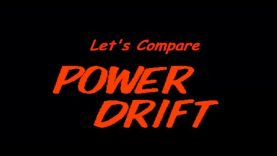Let’s Compare ( Marble Madness )
Gaming History Source
Video Locations:
1. Arcade 0:38
2. ZX Spectrum ( Deluxe Edition ) 2:07
3. Amstrad ( Construction Set Edition ) 3:31
4. Apple 2 5:00
5. DOS 6:28
6. Gameboy 7:57
7. Gameboy Color 9:26
8. Atari ST 10:54
9. Game Gear 12:22
10. Commodore 64 13:51
11. Gameboy Advance 14:55
12. Nintendo Entertainment System 16:23
13. Sega Master System 17:51
14. Genesis 19:21
15. Apple 2 GS 20:49
16. Amiga 22:17
17. Sharp X68000 23:46
18. FM Towns 25:14
19. Windows ( New & Classic Perspectives ) 26:43 – 28:20
Credits: 29:40
DOWNLOAD THE WINDOWS VERSION HERE !!
http://www.lucaelia.com/download.php?file=/downloads/RollingMadness3D-Installer.exe
Description Source:
http://en.wikipedia.org/wiki/Marble_Madness
Marble Madness is an arcade video game designed by Mark Cerny, and published by Atari Games in 1984. It is a platform game in which the player must guide an onscreen marble through six courses, populated with obstacles and enemies, within a time limit. The player controls the marble by using a trackball. Marble Madness is known for using innovative game technologies. It was Atari’s first to use the Atari System 1 hardware and to be programmed in the C programming language. The game was also one of the first to use true stereo sound; previous games used either monaural sound or simulated stereo.
In designing the game, Cerny drew inspiration from miniature golf, racing games, and artwork by M. C. Escher. He aimed to create a game that offered a distinct experience with a unique control system. Cerny applied a minimalist approach in designing the appearance of the game’s courses and enemies. Throughout development, he was frequently impeded by limitations in technology and had to forgo several design ideas.
Upon its release, Marble Madness was commercially successful, becoming a profitable arcade game. Praise among critics focused on the game’s difficulty, unique visual design, and stereo soundtrack. The game was ported to numerous platforms and inspired the development of other games. A sequel was developed and planned for release in 1991, but canceled when location testing showed the game could not succeed in competition with other titles.
GAME PLAY
Marble Madness is an isometric platform game in which the player manipulates an onscreen marble from a third-person perspective. The player controls the marble’s movements with a trackball, though most home versions use game controllers with directional pads. The aim of the game is for the player to complete six maze-like, isometric race courses before a set amount of time expires. When a player completes a race, the remaining time is added to the next race’s allotted time. The game also allows two players to compete against each other.
Courses are populated with various objects and enemies designed to obstruct the player. As the game progresses, the courses become increasingly difficult and introduce more enemies and obstacles. Each course has a distinct visual theme. For example, the first race, titled “Practice”, is a simple course that is much shorter than the others, while the fifth race, named “Silly”, features polka-dot patterns and is oriented in a direction opposite from the other courses.













